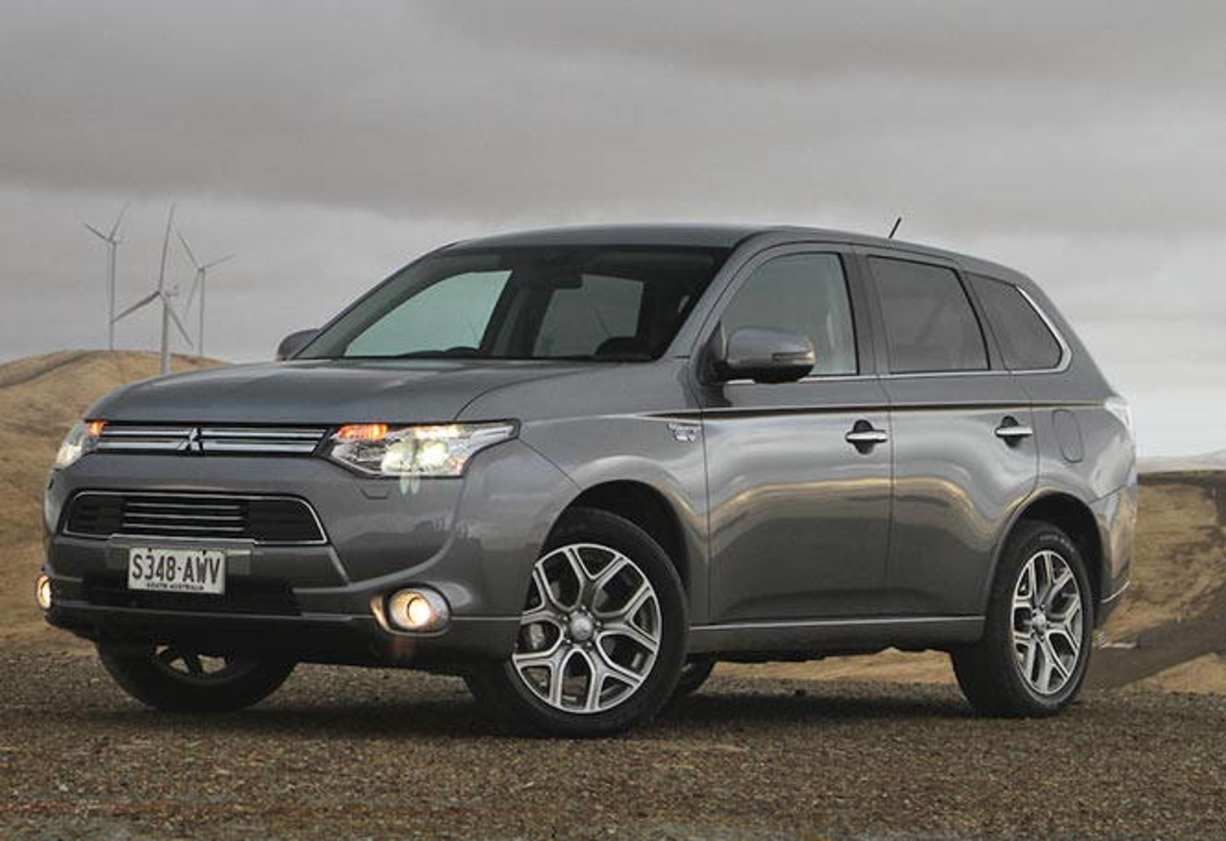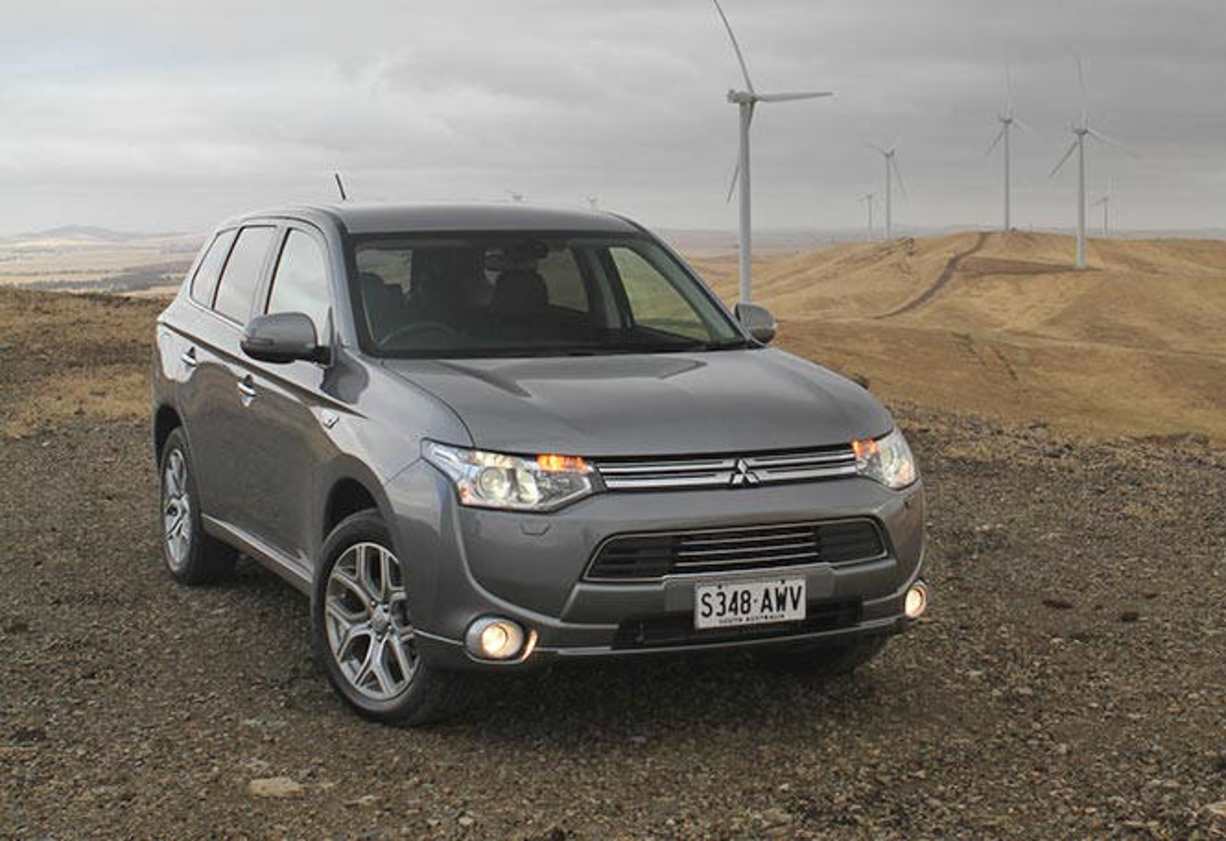Mitsubishi may not be the first on the plug-in hybrid scene, but the new Outlander PHEV - Australia’s second plug-in hybrid model – looks to bring the technology a few notches closer to mainstream appeal.
Holden’s Volt represented a similar advancement as the first plug-in hybrid when it arrived in 2012, with the peace of mind of a range-extending petrol engine paired with the primary electric-drive solving range anxiety for good. However, with an asking price of $59,990 and seating limited to four, Holden sold just 101 units in its first full year on sale.
Mitsubishi has taken electro-assimilation one step further by wrapping a plug-in hybrid drivetrain in the everyday hero guise of a mid-size SUV, with pricing starting from a relatively thrifty $47,490.
Several other manufacturers are preparing their own plug-in hybrids, of all shapes and sizes, but Mitsubishi’s Outlander PHEV is the first to fit within the ever-expanding mid-size SUV segment. It’s also the first all-wheel drive plug-in hybrid, and the most efficient SUV on the Australian market by a long shot.
Value
The Outlander PHEV is available in two trim levels, with the entry Outlander PHEV – Plug-in Hybrid Electric Vehicle and pronounced P-H-E-V – sitting above the existing $46,890 Outlander Aspire turbodiesel at $47,490. The top Outlander PHEV Aspire still represents good value in the plug-in hybrid stakes at $52,490.
The cheaper Outlander PHEV is similar to the regular LS grade in terms of spec, and includes cloth trim, dual-zone climate control, a 7-inch multimedia screen with satnav, reversing camera with rear parking sensors, Bluetooth phone and audio, proximity keys, auto headlights and wipers.
The top PHEV Aspire is similarly related to the petrol and diesel Aspire models, with leather trim, heated front seats, 6-way power driver’s seat adjustment, electric sunroof, power tailgate with remote operation, forward collision mitigation, adaptive cruise control, and a WiFi-based smartphone app remote control system that enables you to monitor the vehicle’s status or schedule air conditioning or charging remotely.
Design
There’s little more than a chrome grille and unique badging to set the Outlander PHEV models aside from the rest of the recently updated Outlander lineup, and both PHEV variants wear the same 18-inch wheels as the petrol and diesel Aspire models.There’s even less differentiation between the two PHEV variants visually, with chrome sill trim and door handles to signify the PHEV Aspire.
Mitsubishi touts the Outlander PHEV as the first compromise-free plug-in hybrid, and aside from being limited to five seats due to the location of hybrid system’s inverter, about 2-inches less toe room in the rear due to the sub-floor battery pack, the spare tyre being replaced by a puncture repair kit, and a slightly higher boot floor reducing cargo space from 477-463-litres, the remaining five positions are largely unaffected by the Outlander PHEV’s drivetrain.
A 1500kg braked tow capacity is 500kg shy of the diesel Outlander and 100kg fewer than petrol models, but still impressive considering the likes of Toyota’s Camry Hybrid drops from 1200kg to an almost useless 300kg.
Technology
The Outlander PHEV’s 1.9L/100km official combined fuel figure is probably its biggest claim to fame. Second only to the 1.2L/100km Volt in the petrol efficiency stakes, the Outlander primarily relies on front and rear 60kW electric motors for motive force. A pure-electric range of 52km is claimed, and a range-extending 87kW 2.0-litre petrol engine enables confident long-distance travel.
All drive sources are connected to the road via fixed single-speed ratios to suit each motor’s optimum operating range, and are activated by a series of automated clutches.
The drivetrain operates in three automatically selected drive modes. EV mode uses solely the two electric motors and is capable of up to 120km/h under light throttle. Series mode kicks in when more performance is required or when the battery level is low, and sees the petrol engine charge the battery while the electric motors provide the drive. Parallel mode is activated at higher speeds or when maximum performance is required, and sees the petrol engine driving the front wheels directly in addition to the front and rear electric motors.
Regenerative braking can be optimised by the driver by selecting three different levels from the consoled shifter, or six different levels from the steering wheel mounted paddle shifters. If left to its own devices, the PHEV will regenerate energy to a lesser degree whenever the brakes are applied.
Mitsubishi claims performance in excess of the current 2.0 and 2.4-litre petrol and 2.2-litre turbodiesel Outlander drivetrains, and similar to the previous V6 petrol engine, but does not make any official 0-100km/h claims.
The Outlander PHEV steps up from the existing models’ on-demand all-wheel drive system to a more advanced torque vectoring setup, and a 4WD-lock mode splits drive equally front to rear for very slippery conditions like snow or mud.
The hybrid system’s 12kWh lithium ion battery pack is located beneath the cabin floor, which can be recharged from a 15 Amp household power point in five hours with the on-board charging cable. Standard Australian household power points are rated at 10 Amps, but can be upgraded to suit the Outlander PHEV for a few hundred dollars.
A console button-activated Battery Charge mode uses the petrol engine to restore 80 percent of charge in 40 minutes while stationary - burning about 3-litres of fuel in the process – which can also be put to use when on the move. An also-console button activated Battery Save mode allows the driver to reserve remaining battery charge at its existing level.
Safety
ANCAP has officially extended the regular Outlander lineup’s five star rating to include the PHEV.
Driving
After proving just what the Outlander PHEV is capable of in Mitsubishi’s Eco Drive challenge, we had the chance to test the outer-limits of its abilities as a long-distance cruiser and outdoor adventure machine. We also reverted to a standard approach to acceleration and speed limits.
Like anything with an electric-drive bias, the Outlander PHEV is delightfully serene when moving from rest, and this EV model situation does not change under regular throttle use and while there’s sufficient charge in the battery system.
As acceleration loads increase, Series mode kicks in and out as needed with petrol engine assistance, but the petrol engine can barely be detected from the driver’s seat as it essentially idles away as a generator - and largely drowned out by ambient road noise.
When asking for rapid acceleration, the petrol’s engine intervention is more audible as the PHEV shifts to Parallel mode, and tends to sit at high rpm like vehicles with a CVT transmission.
The Outlander PHEV doesn’t offer the instant torque whack from rest that characterises most other electrified models, which is largely due to each motor using a separate fixed drive ratio. Each motor is staggered according to its most efficient speed and load range, so intentionally don’t deliver their best at the same time in the name of energy efficiency. Each drive ratio is different, so the PHEV effectively has a three speed transmission, with a separate motor to suit each ratio.
At highway speeds, the PHEV’s continual priority for electric power makes for a partially serene cruising experience, with the simplified environment effectively amplifying road noise, surface changes, and a persistent dash rattle on our test car. The electric steering doesn’t offer much in the way of feel, there’s a bit of sway through corners, and the ride can be sharp on the low profile 18-inch rubber. It’s still a mainstream Outlander underneath all that plug-in tech after all, but still an easy place to spend several hours at the wheel.
Mitsubishi’s drive route also included an extended off-road fire trail loop, with ruts and erosion humps that would scare away many soft road owners. The PHEV impressed with its readiness for such a weekend escape route, despite the slightly reduced ground clearance due to the underslung battery system. Any concerns over the battery pack’s readiness for such rugged use should be allayed by the thick sheet steel that encases the expensive lithium-ion cells.
The torque vectoring all-wheel drive system provided sure-footedness over loose rocky sections, and we saw the average fuel consumption figure reach a peak of 6.9L/100km. Conventional vehicles will experience a similar jump in fuel consumption on slow off-road climbs, and 6.9L is still less than what most medium SUV’s will record on the highway.
After 200km of high speed cruising and off-road fire trails, the PHEV’s average fuel consumption readout showed a 6.2L/100km figure. A significant jump from its official 1.9L/100km combined figure, but under conditions well outside the PHEV’s everyday urban focus and a figure far lower than what you’d expect conventionally-fuelled rivals attempting the same.
Verdict
Mitsubishi has managed to cram state of the art plug-in technology within one of our favourite body styles for a realistic price. Based on our experience so far, the Outlander PHEV will save plenty of fuel during everyday driving, and still return a pretty impressive result on longer journeys or when venturing into the wild. If you can justify the extra price over a conventionally fuelled mid-size SUV, it’s a pretty compelling option for everyday use.
Mitsubishi Outlander 2014: Ls (4X4)
| Engine Type | Diesel Turbo 4, 2.3L |
|---|---|
| Fuel Type | Diesel |
| Fuel Efficiency | 5.8L/100km (combined) |
| Seating | 7 |
| Price From | $10,560 - $14,520 |
| Safety Rating |
|
Pricing Guides




















.jpg)
.jpg)








.png)











